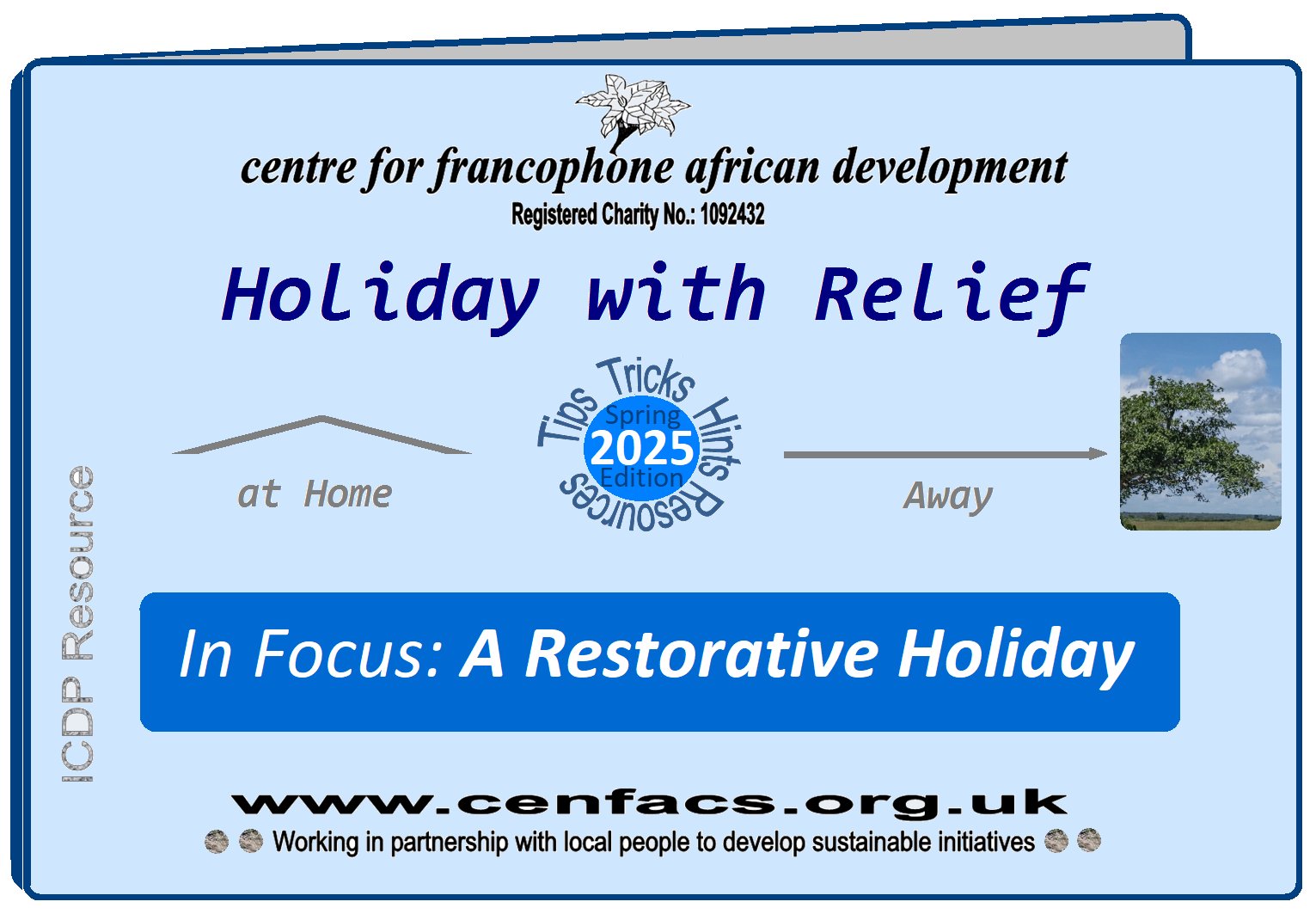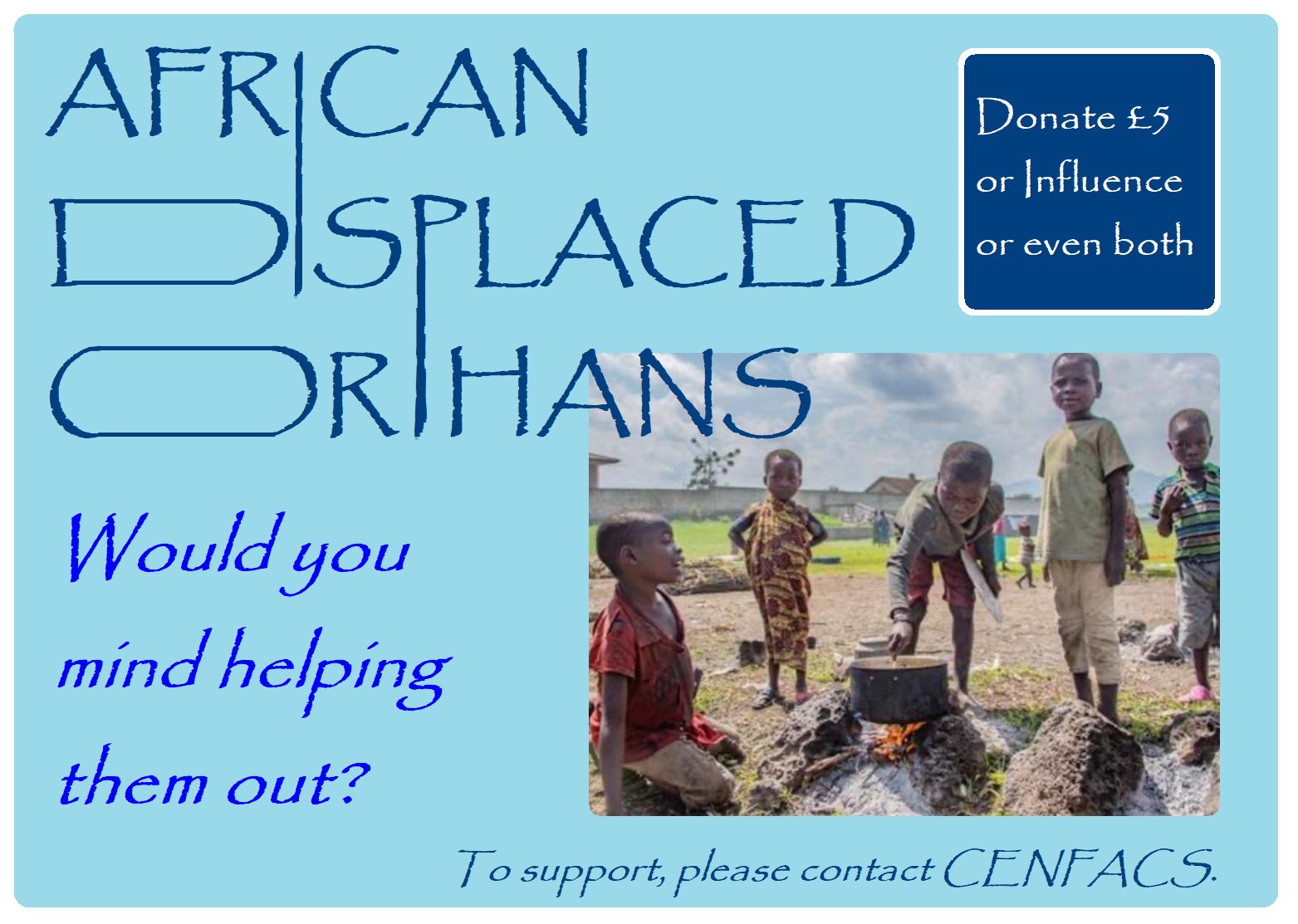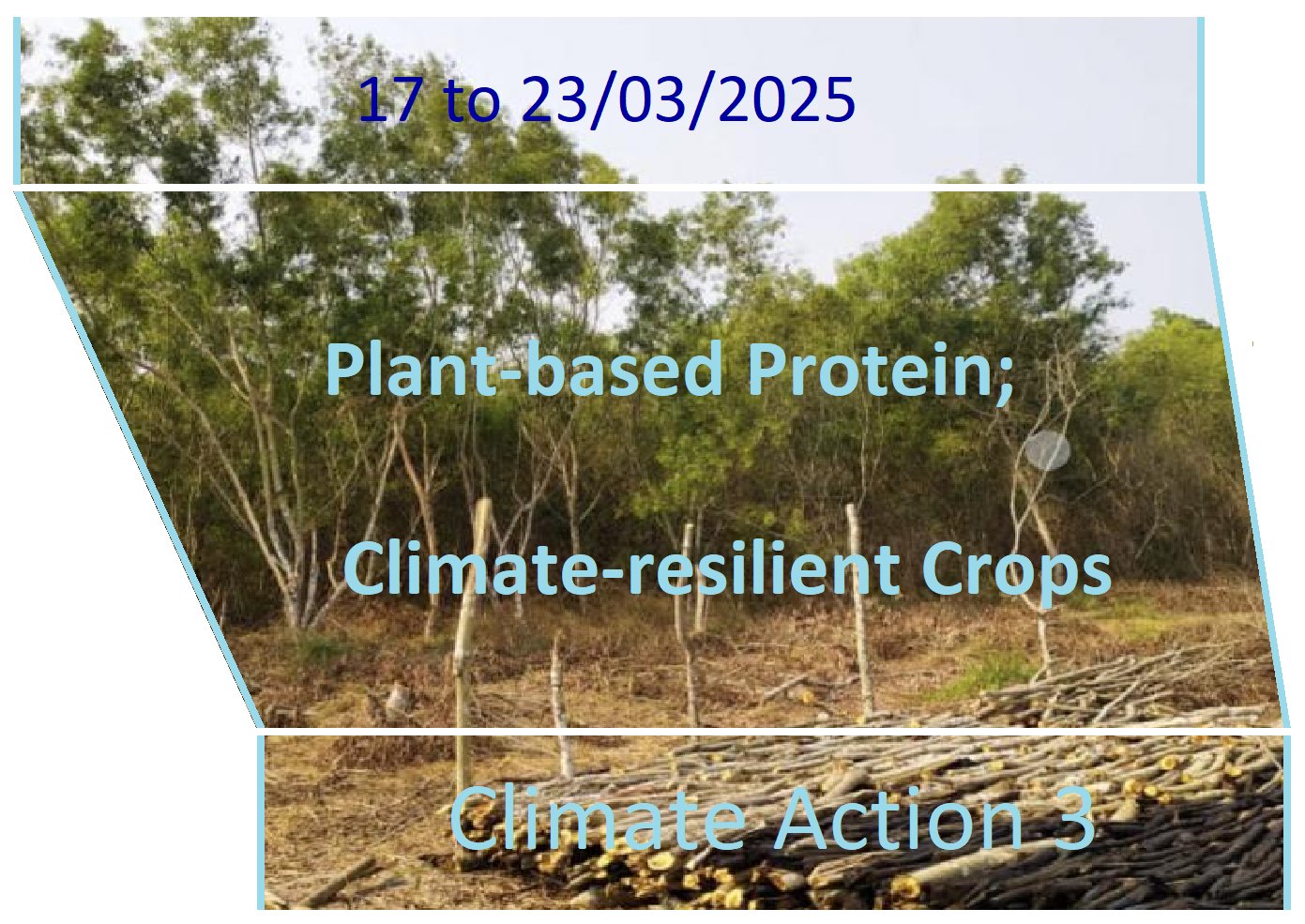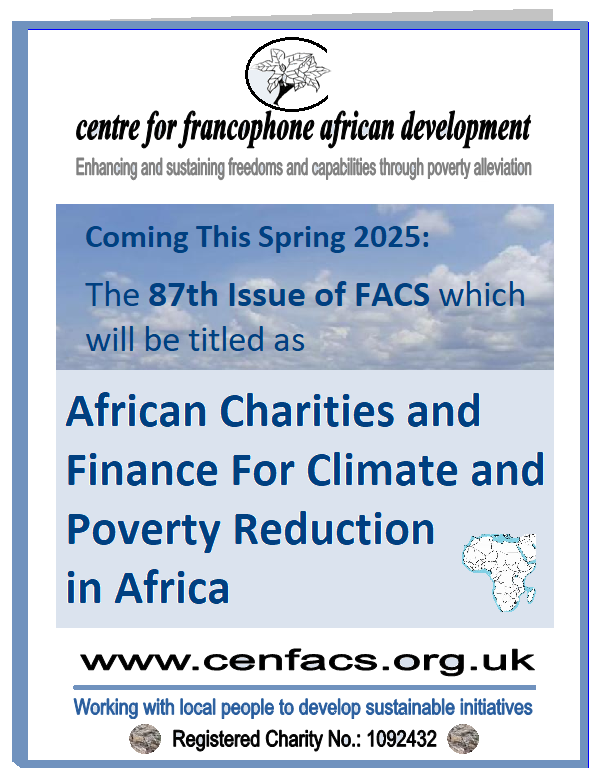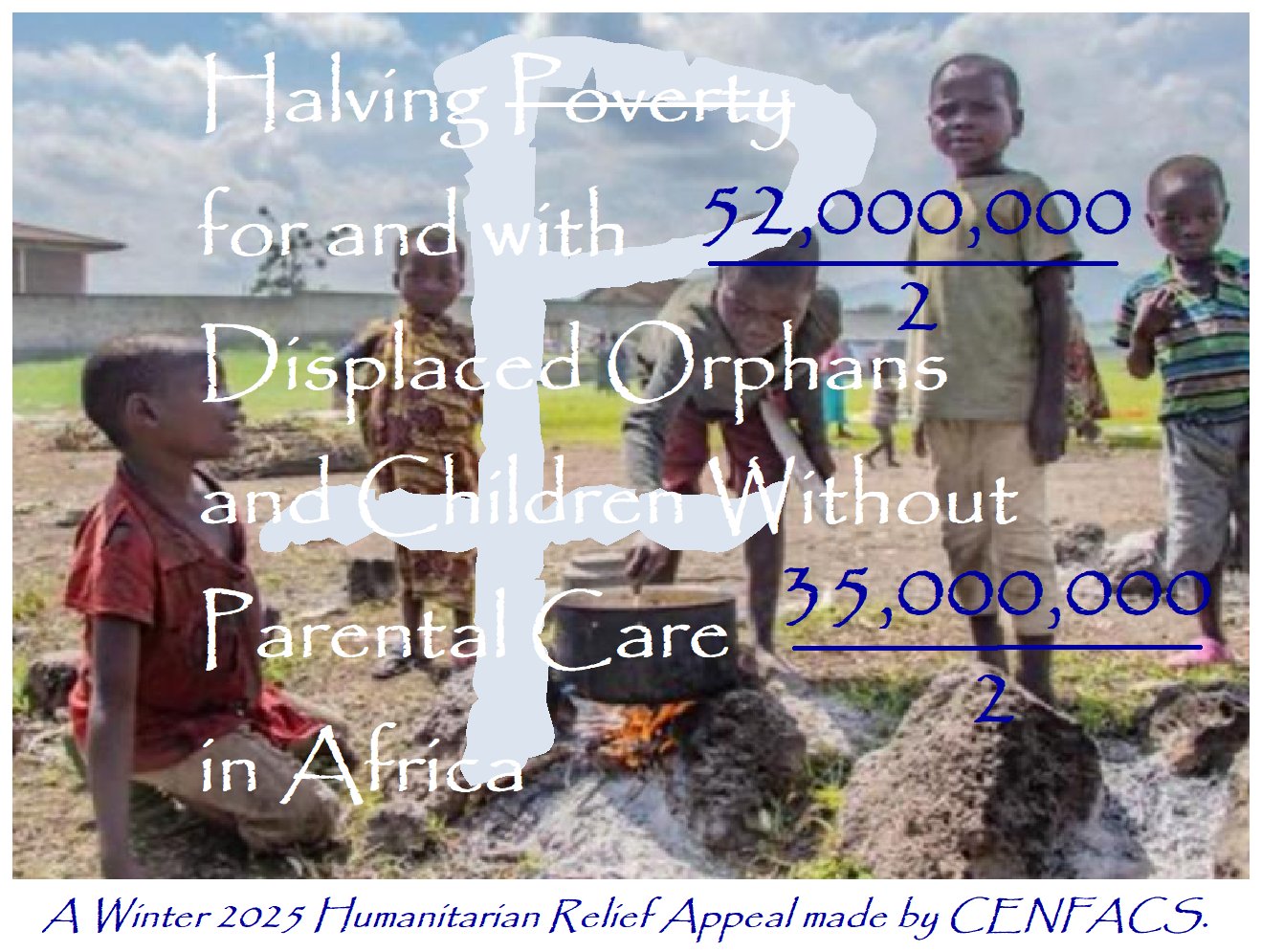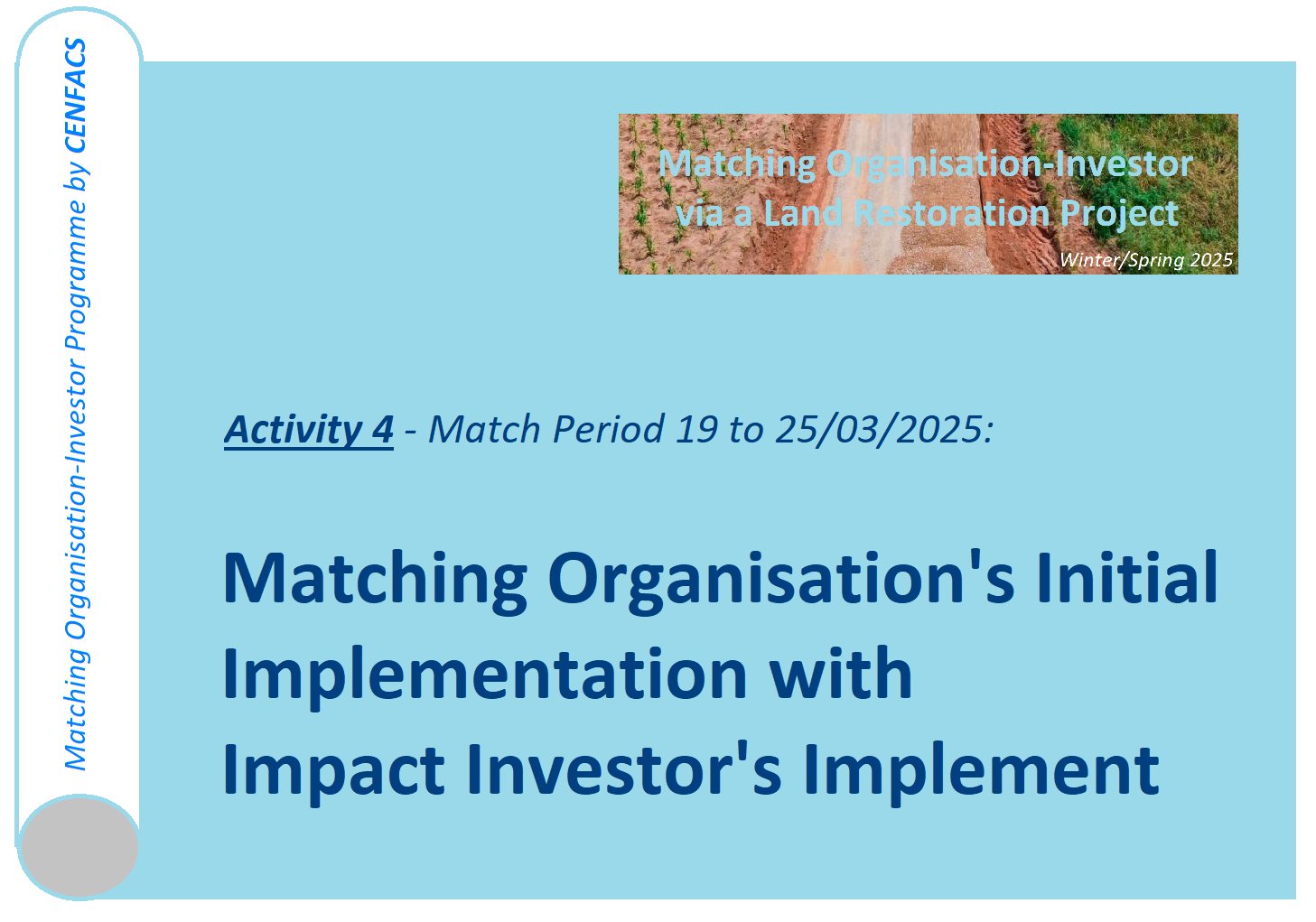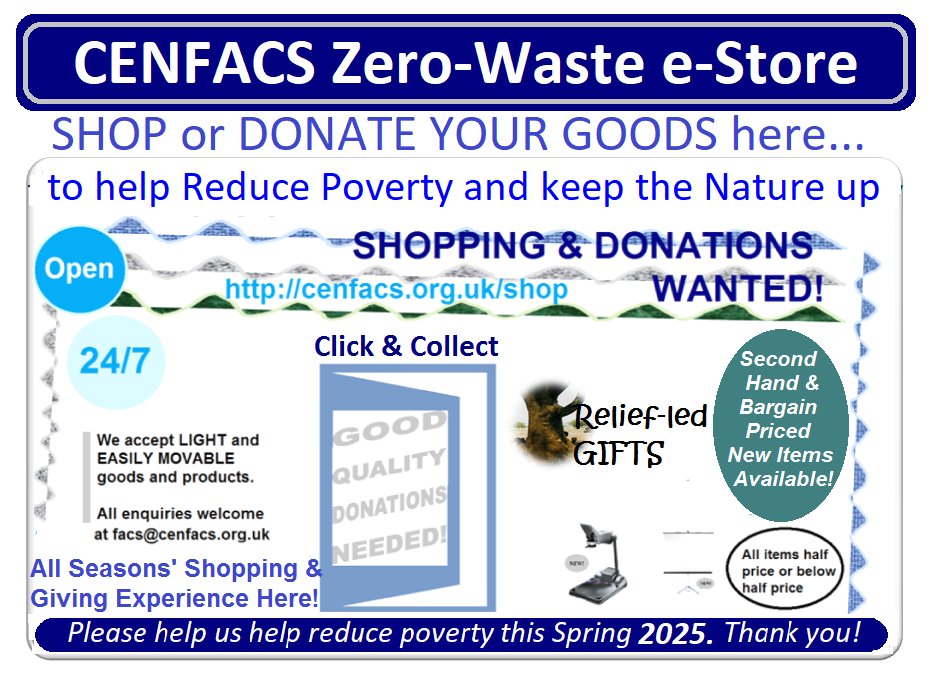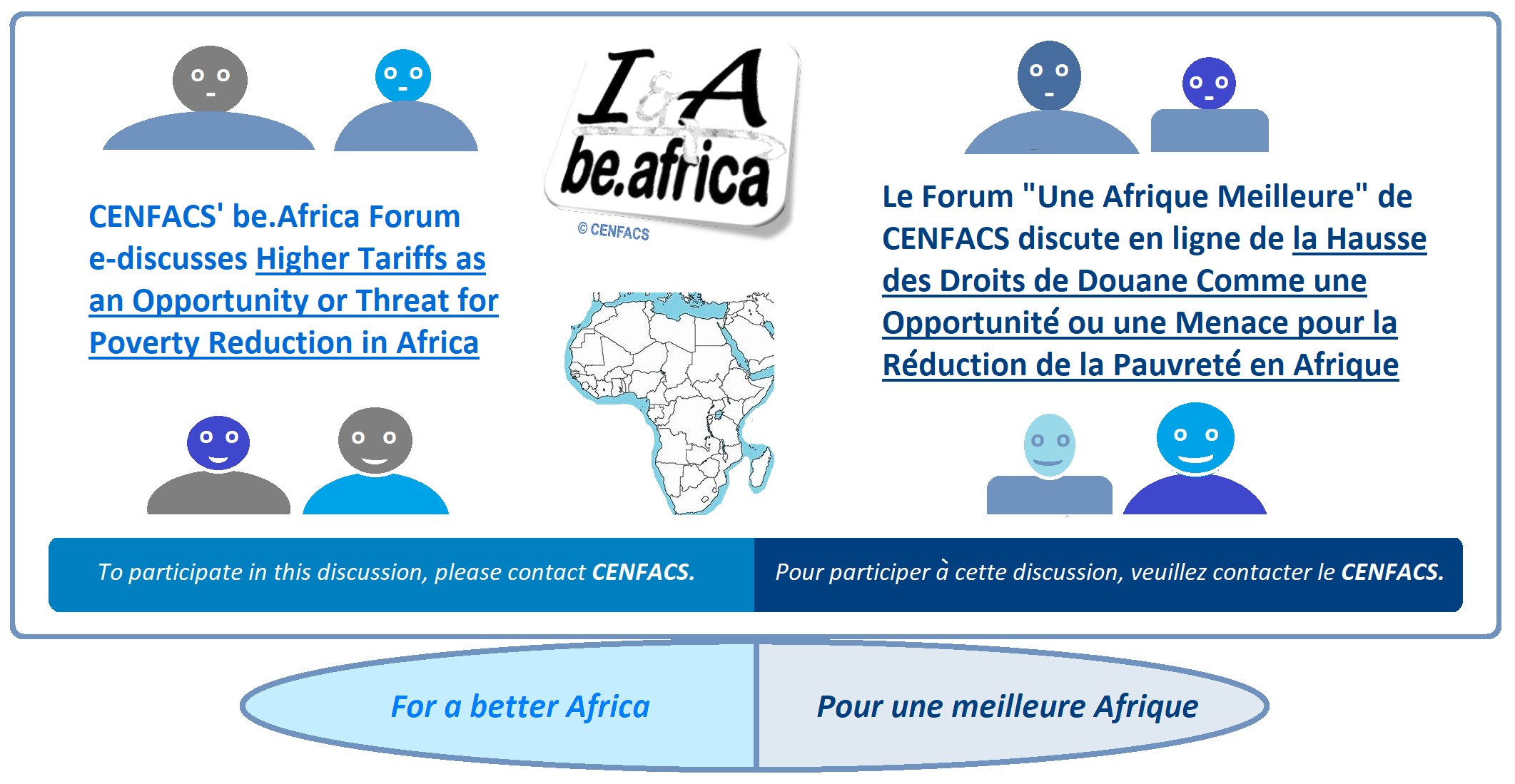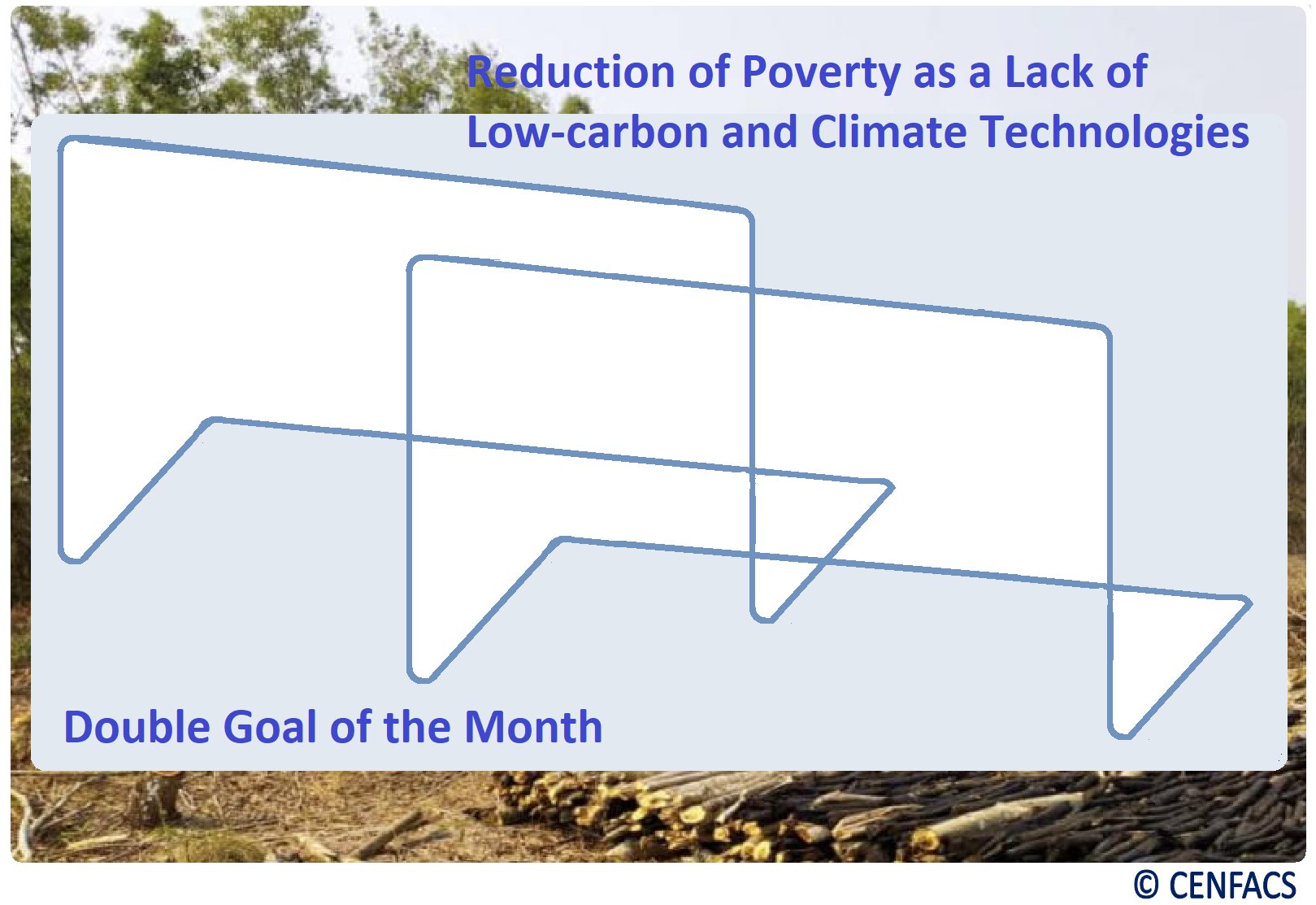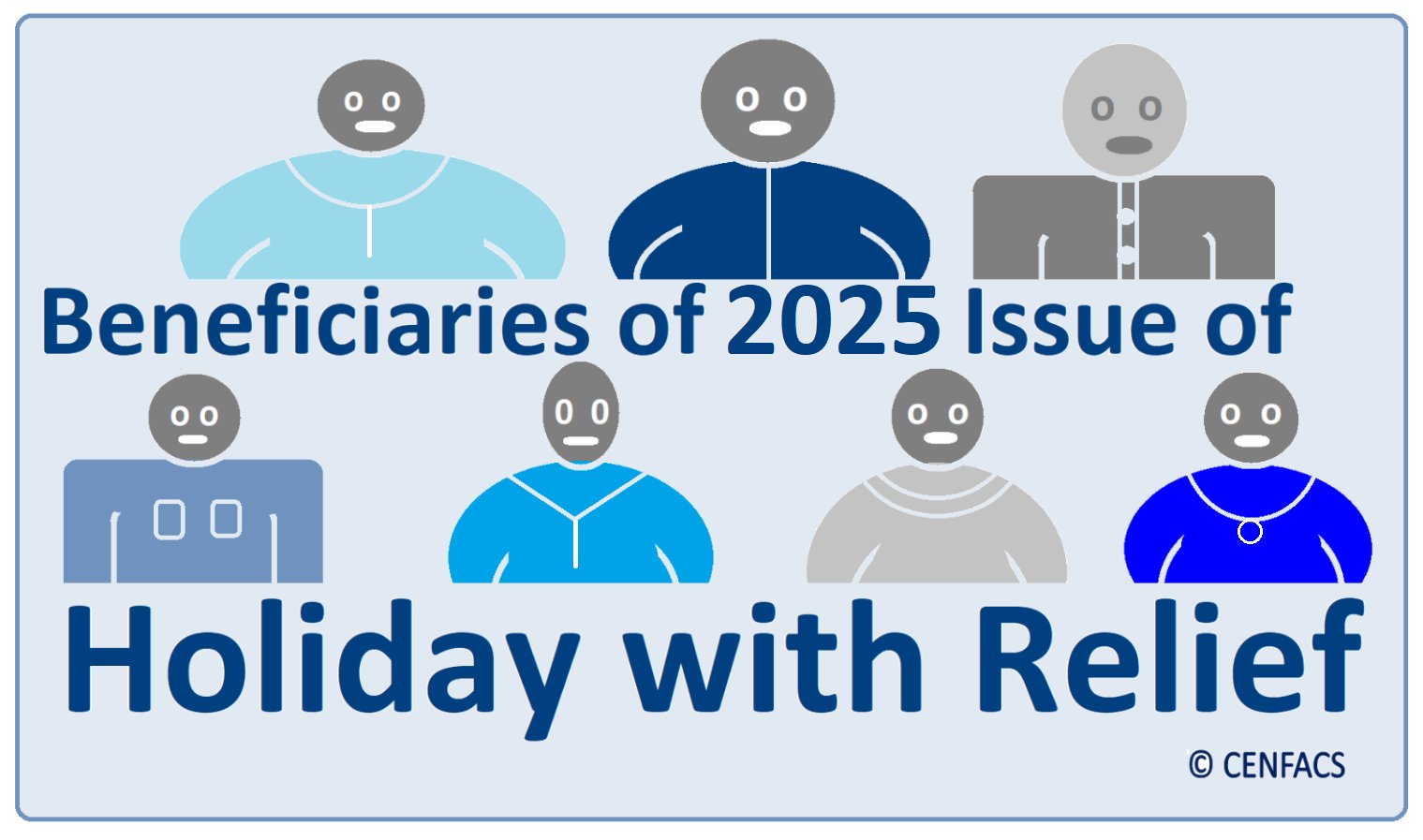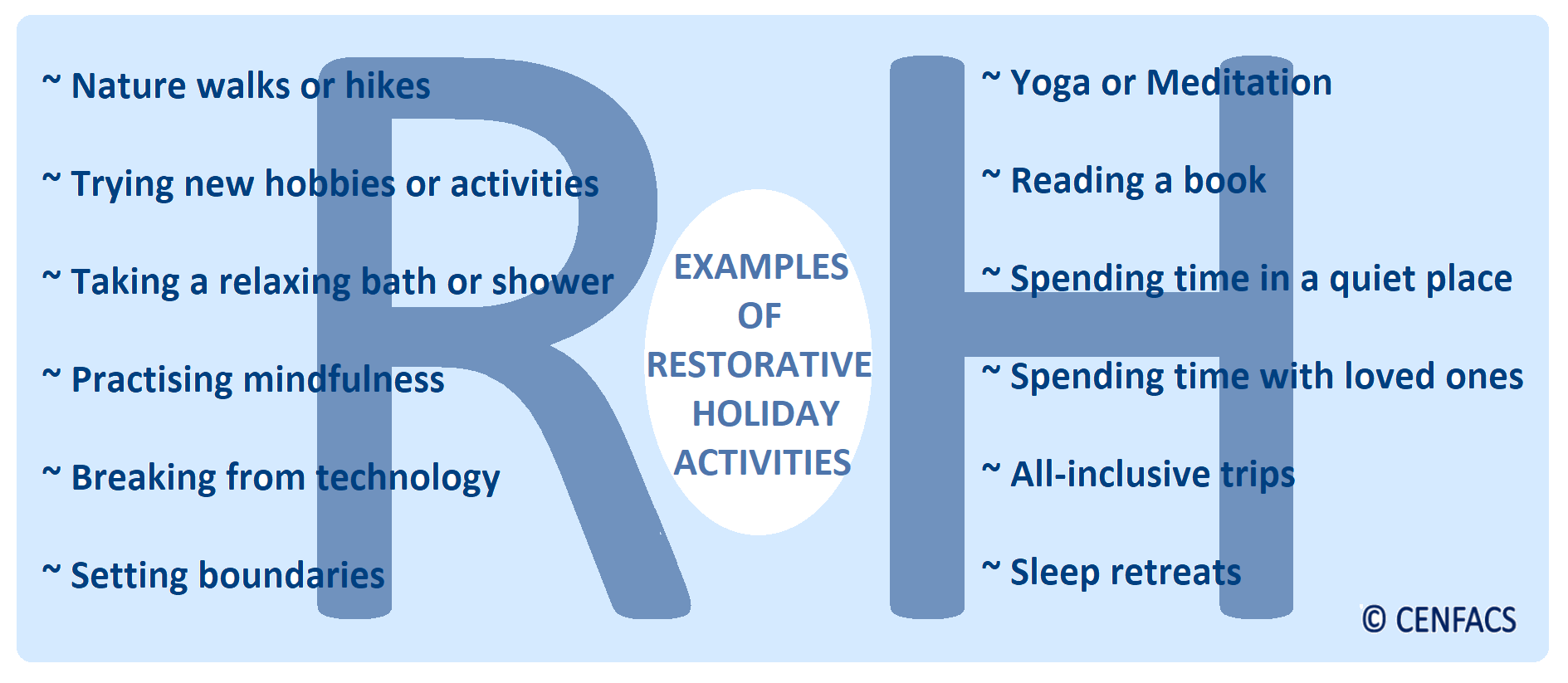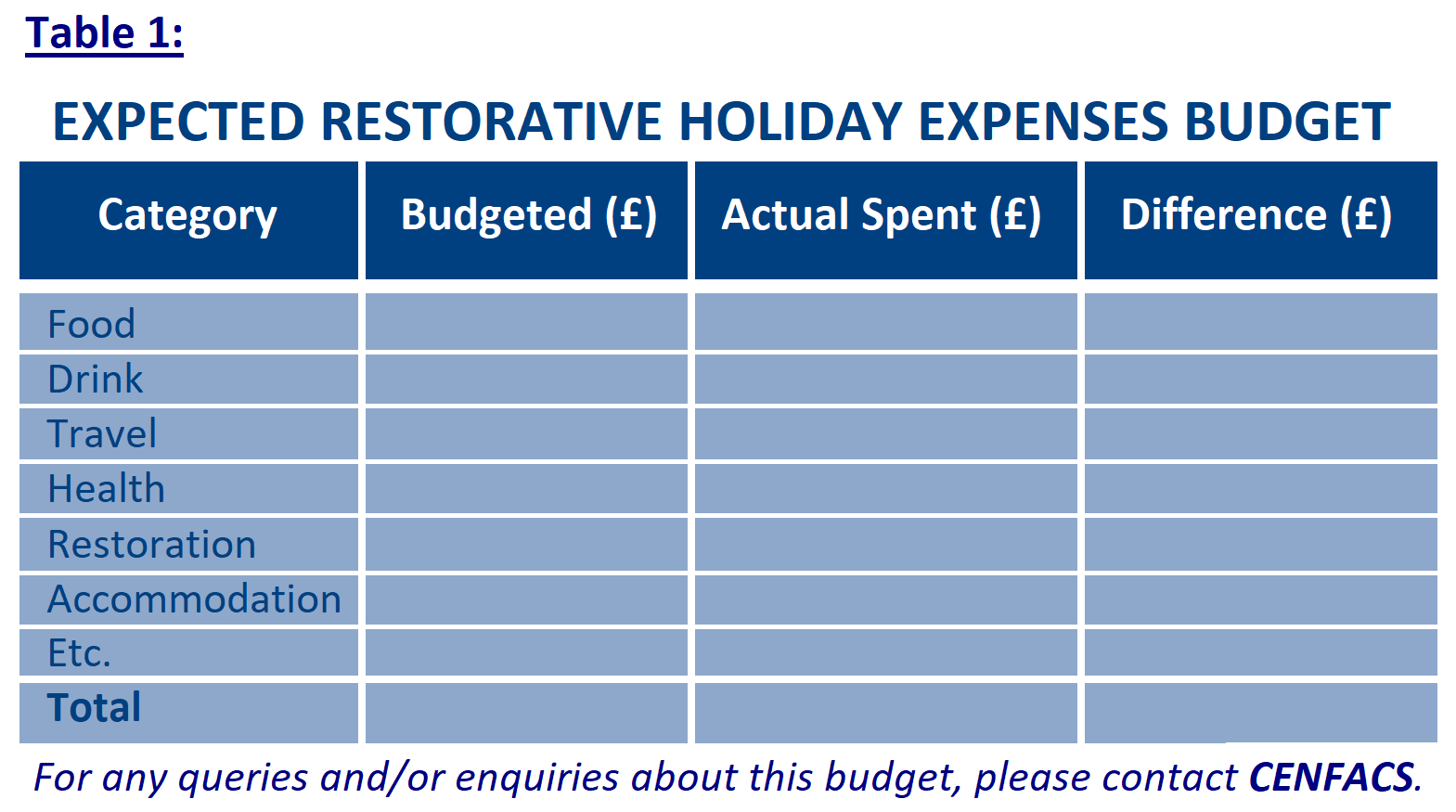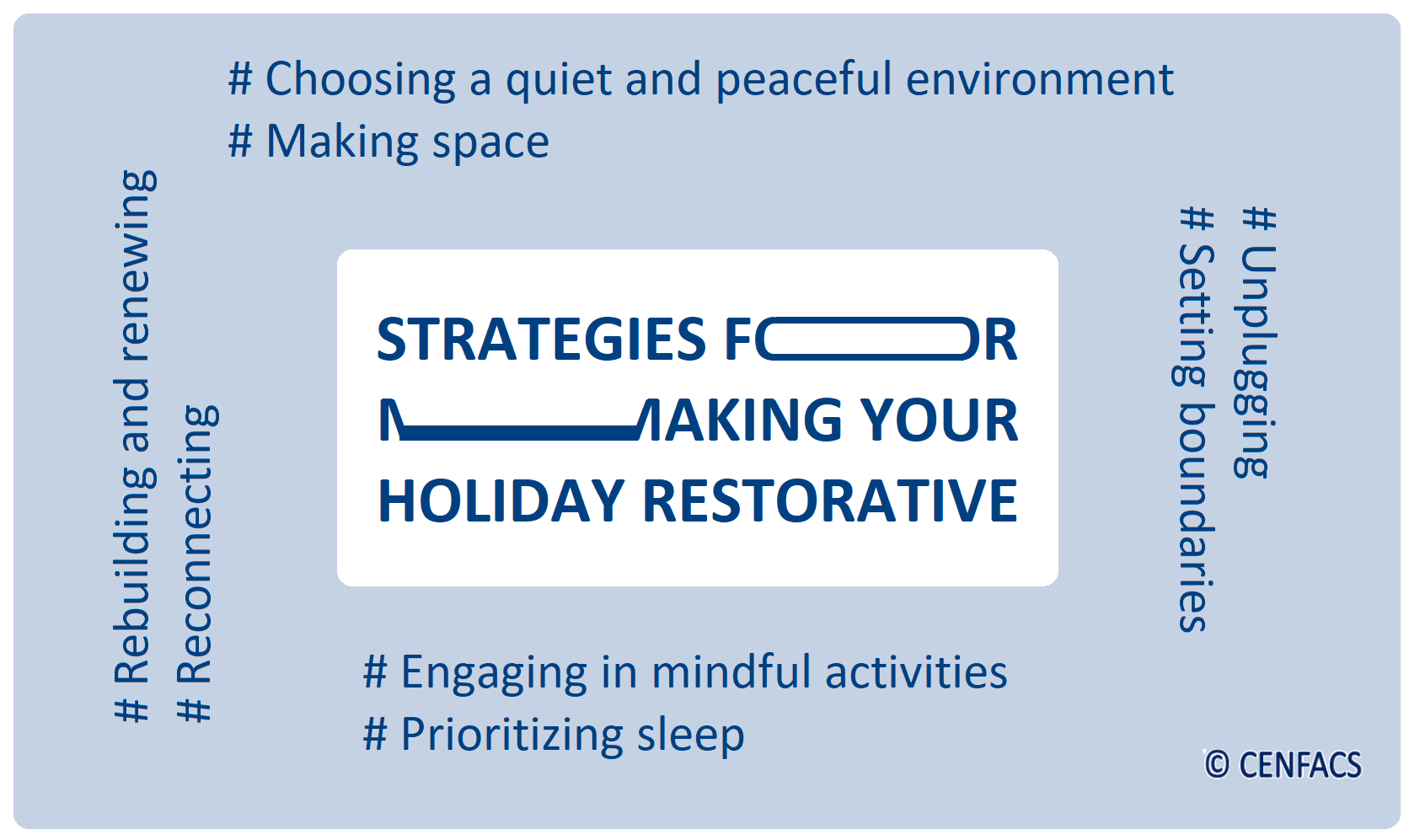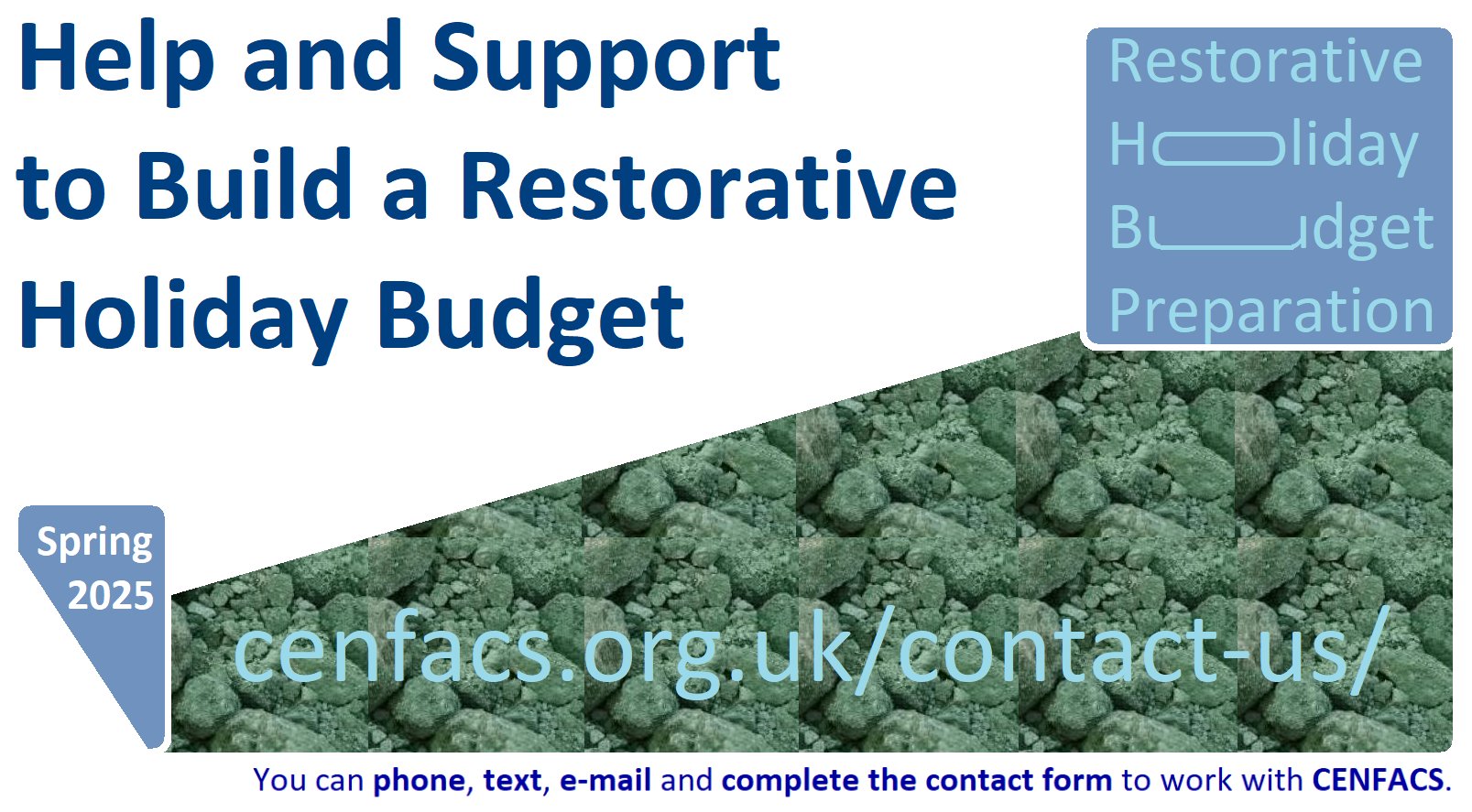Welcome to CENFACS’ Online Diary!
19 March 2025
Post No. 396
The Week’s Contents
• ICDP (Individual Capacity Development Programme) Resource, Holiday with Relief – In Focus for Spring 2025 Issue: A Restorative Holiday
• Climate Action 3 – In Focus from 17 to 23/03/2025: Plant-based Protein; Climate-resilient Crops
• Coming This Spring 2025: FACS Issue No. 87 Which Will Be Titled as African Charities and Finance for Climate and Poverty Reduction in Africa
… And much more!
Key Messages
• ICDP (Individual Capacity Development Programme) Resource, Holiday with Relief – In Focus for Spring 2025 Issue: A Restorative Holiday
How to use your holiday to improve your health, strength and spirits
The current Issue of our ICDP Resource entitled as ‘Holiday with Relief’ focuses on a Restorative Holiday. The Issue echoes the year’s dedication within CENFACS of 2025 as a Year of Restoration. It also comes at the right time as we shall enter soon Spring Relief 2025 within CENFACS; season of Rebuilding and Renewing Lives, Infrastructures and Institutions.
A Restorative Holiday happens when one uses its holiday to improve their health, strength and spirits, or any other aspects of their life. In this respect, the aim of a restorative holiday is to provide a break from daily life, focussing on rejuvenation, relaxation, and reconnection with oneself, family, or nature. It is about making space for rest, rebuilding and renewing, often through activities like quiet relaxation, wellness retreats, or disconnecting from technology.
As Everwell Mama (1) puts it,
“A restorative holiday reset helps busy moms get their energy and joy back”.
This year, ‘Holiday with Relief’ provides wealthy advice, tips and hints to improve health, strength and spirits during your holiday. Through this wealth of information, we will try to tackle poverty linked to the lack of break to refresh one’s mind and body.
Therefore, the purpose of this year’s Issue of ‘Holiday with Relief’ is to work with our users in order to find way of having enjoyable and streamlined poverty-relieving holiday experience by focussing on activities that genuinely rejuvenate, relax, and reconnect them with themselves, their families and nature. It is about breaking in order to improve performance, focus and creativity.
The resource is packed with Spring-like poverty-relieving ideas about how to reduce poverty linked to the lack of restorative holiday. Although the contents of this year’s ‘Holiday with Relief’ will be for holiday, they can also be used for restorative breaks.
Concerning restorative breaks, the website ‘focuskeeper.co’ (2) explains that
“Restorative breaks are any short periods of time away from tasks that allow individuals to refresh their minds and bodies. Unlike typical breaks, which may involve mindless scrolling on social media or simply standing up to stretch, restorative breaks focus on activities that genuinely rejuvenate us”.
This definition of restorative breaks will help in providing tips and hints which are included in this 2025 Issue of Holiday with Relief.
Key highlights or content summaries about the 2025 Issue of Holiday with Relief are given under the Main Development section of this post.
• Climate Action 3 – In Focus from 17 to 23/03/2025: Plant-based Protein; Climate-resilient Crops
This third climate action deals with protein found in plants only and crops that are resilient to stress factors. This action is on both plant-based protein as a low-carbon technology and climate-resilient crops as climate technologies. This action will be taken around the following headings:
~ What is plant-based protein?
~ What are climate-resilient crops?
~ Working with the Community on plant-based protein and climate-resilient crops.
Let us explain each of these headings.
• • What Is Plant-based Protein?
There are many ways of defining plant-based protein. One of its definitions comes from ‘geneticnutrition.in’ (3). According to the website ‘geneticnutrition.in’,
“Plant-based protein refers to proteins derived entirely from plant sources such as beans, lentils, peas, nuts, seeds, grains, and vegetables. Unlike animal proteins found in meat, dairy, and eggs, plant proteins are entirely vegan, meaning they contain no animal products”.
The same ‘geneticnutrition.in’ provides six benefits of plant-based protein which are:
σ Nutrient-dense and low in calories
σ Supports heart health
σ Environmentally friendly
σ Digestive benefits
σ Supports muscle growth and recovery
σ Rich in antioxidants and phytochemicals.
Further to the benefits of plant-based protein, this week’s climate action is to encourage the production and consumption of plant-based protein, especially for those who are unaware of these benefits.
• • What Are Climate-resilient Crops?
The survey of the literature about climate-resilient crops provides many definitions. One of them comes from Farmers Click (4). According to the later,
“Climate-resilient crops are plant varieties that can withstand extreme weather conditions, such as drought, floods, high temperatures, and salinity while maintaining productivity”.
Farmers Click provides five features about these crops, which are:
σ drought-tolerant
σ heat-resistant
σ salt-tolerant
σ flood-resistant
σ pest and disease-resistant.
Because the health of crops can be affected by extreme weather conditions, it makes sense to act in building their resilience.
For example, Karine Prado et al. (5) argues that there are emerging technologies and approaches that could enhance crop resilience, such as synthetic biology, advanced breeding techniques, and high-throughput phenotyping.
Briefly, it is possible to choose plant-based protein or options which reduce one’s carbon footprint; just as it is feasible to improve the resilience of crops against climate stressors.
• • Working with the Community on Plant-based Protein and Climate-resilient Crops
The all purpose of writing this note is to guide our action. In other words, what is key here is to take action. The note is only a guided principle.
For instance, taking action together could be on the following:
~ how to help our community members to embrace plant-based options
~ advocating for sharing and transferring technologies between Africa and the rest of the world, included technologies linked to plant-based protein and climate-resilient crops
~ educating the members of the CENFACS Community who are unaware of help deriving from taking a plant-based drive
~ explaining the benefits of plant-based proteins which require significantly fewer resources – such as water and land – and produce fewer greenhouse gas emissions compared to animal farming
~ reducing and/or ending poverty linked to the lack of access to plant-based protein as a low-carbon technology and climate-resilient crops as climate technologies.
Those members of our community in the UK and Africa-based Sister Organisations willing to work with CENFACS on Plant-based Protein and Climate-resilient Crops as well as on Poverty Reduction linked to them; they can take climate actions with us.
For any queries or enquiries about Climate Action 3 and Climate Actions Month, please do not hesitate to contact CENFACS.
• Coming This Spring 2025: FACS Issue No. 87 Which Will Be Titled as African Charities and Finance for Climate and Poverty Reduction in Africa
To raise funds to deal with climate change and poverty issues, African Charities experience all sorts of challenges and barriers. Yet, there are needs to implement climate and poverty reduction goals.
For instance, the report from ‘greenfinanceplatform.org’ (6) indicates that
“African governments have committed to mobilising around 10 percent of their need domestically, this leaves an immense gap – around 80 percent or $2.5 trillion – in climate finance that is needed to achieve climate mitigation and adaptation targets in Africa”.
Additionally, with all the cuts that have been done here and there in the developed worlds regarding their aid budgets, these cuts can only exacerbate the gap in funding for poverty reduction in Africa. So, there is a funding gap for climate issues; just as there is financial aid vacuum for poverty reduction in Africa.
Whether it is for climate or poverty reduction, African Charities need funding for both to continue and sustain their mission while improving lives of those in need. They require climate finance to help mitigate and adapt to climate change impacts; just as they need finance to address the root causes and consequences of poverty in Africa. This is what the 87th of FACS will be about.
The 87th Issue of FACS will deal with the strategies and tools that African Charities (ACs) use or can use to undertake climate planning and budgeting as well as frame their investment bid in order to seek and secure or mobilise funds.
It will study how ACs try to access funds through capacitated and empowered local institutions where they operate. This is without ignoring any efforts they may do to work with the private or for-profit sector on climate change issues. In other words, the 87th Issue of FACS will investigate how ACs try to collaborate and partner with others to improve their capacity and coordination issues relating to climate finance.
The 87th Issue will also deal with finance for poverty reduction. Indeed, securing climate finance does not necessarily imply obtaining finance for poverty reduction. That is why the Issue will also work on the use of financial instruments that enable ACs to access funds and respond to the needs of their users and of locals. In this respect, the 87th Issue will check if there is an alignment between ACs strategy for climate finance and finance for poverty reduction. And if there is, where this alignment lead to.
The 87th Issue will analyse the relationship between climate finance and finance for poverty reduction. Specifically, it will highlight the interconnectedness between climate change and poverty. It is known that climate change can exacerbate poverty by causing natural disasters, food insecurity, and displacement, while poverty can make people and communities more vulnerable to climate impacts.
Far from being a catalogue of challenges and barriers, the 87th Issue will look at if there are some improvements in ACs finance strategies regarding both climate and poverty reduction issues. In particular, the 87th Issue will argue about the following:
σ the integration between strategy for climate finance and strategy relating to finance for poverty reduction since there are synergies between climate change and poverty reduction initiatives
σ the model of working together between ACs and all other actors in mobilizing climate finance and finance for poverty reduction and sustainable development
σ the alignment between climate finance and finance for poverty reduction
σ the improvement of ACs project planning that does not only reflect the needs of climate, but also those of living in poverty in Africa
σ the tracking of both climate funds and funds for poverty reduction and sustainable development
σ the development of frameworks that include both climate investment and impact investing in poverty reduction
σ the improvement in planning and coordination between climate change projects and poverty reduction projects
etc.
To read more about this new Issue, please keep checking on CENFACS incoming posts this Spring 2025. To reserve a paper copy of this 87th Issue of FACS, please contact CENFACS with your mailing details.
Extra Messages
• Matching Organisation-Investor via Land Restoration Project – Activity 4 (from 19 to 25/03/2025): Matching Organisation’s Initial Implementation with Impact Investor’s Implement
• All-year Round Projects Cycle (Triple Value Initiatives Cycle) – Step/Workshop 5: Negotiating and Agreeing Your Play, Run and Vote Projects
• Shop at CENFACS’ Zero Waste e-Store during This Coming Spring Giving Season
• Matching Organisation-Investor via Land Restoration Project – Activity 4 (from 19 to 25/03/2025): Matching Organisation’s Initial Implementation with Impact Investor’s Implement
The fourth episode of our 5-week Matching Organisation-Investor via Land Restoration Project is about Matching Organisation’s Initial Implementation with Impact Investor’s Implement.
Both parties (i.e., Africa-based Sister Charitable Organisation and Not-for-profit Impact Investor) have worked hard in every step of the way of the serialisation and fragmentation of this Project. They have so far made noticeable progress, as they have continued to score points. These scored points are enough to enable them to enter the fourth stage of the matching talks.
For Africa-based Sister Charitable Organisation (ASCO), initial implementation is about getting crews in the field to start the physical restoration activities. For Not-for-profit (n-f-p) Impact Investor, implement is the process of carrying out the restoration intervention on the ground. Both of them may be talking about the same thing. But, let us look at what they mean through the following headings:
σ Negotiation between ASCO and Not-for-profit Impact Investor
σ Agreement
σ The Match or Fit Test.
• • Negotiation between ASCO and Not-for-profit Impact Investor
This negotiation will happen around ASCO’s Initial Implementation and Not-for-profit Impact Investor’s Implement.
• • • ASCO’s Initial Implementation
To explain what is going to happen here, let us start with the meaning of implementation. The website ‘projectmanager.com’ (7) states that
“Project implementation, or project execution, is the process of completing tasks to deliver a project successfully. These tasks are initially described in the project plan, a comprehensive document that covers all areas of project management”.
From the above definition, it is possible to describe what initial implementation is. The website ‘implementationpractice.org’ (8) explains that
“Initial implementation begins when staff initiate the use of the programme or practice or parts of an initiative; it is a time of learning, with attention to using data for continuous improvement and for identifying and addressing adaptive issues that may affect implementation. As improvement efforts are identified and infrastructure needs potentially shift, an implementation plan helps in tracking changes over time”.
To demonstrate that it is taken its initial implementation seriously, ASCO needs to craft and have an implementation plan (that is, a document that describes the necessary steps for the execution of a project). It will make sure that the implementation contains the following elements: project goals and objectives, success criteria, project deliverables, scope statement, resource plan, risk analysis, implementation timeline, implementation milestones, team roles and responsibilities, and implementation plan metrics (e.g., Key Performance Indicators, Objectives and Key Results, etc.).
• • • Not-for-profit Impact Investor’s Implement
Referring to its own understanding of implementation, the n-f-p Impact investor will check if ASCO follows the key steps in project implementation. To be sure, the n-f-p Impact Investor would like some clarification or answers to the following questions:
Q: Does ASCO have an implementation plan to help those who are going to implement the Land Restoration Project to better execute and track the project?
Q: How will ASCO handle changing conditions relating to natural systems in the outdoors?
Q: What is the level of adaptable process to adjust if weather and landscape conditions change?
ASCO is required to satisfactorily respond to the above-mentioned questions if it wishes to secure funds from the N-f-p Impact Investor.
• • Agreement
In order to reach an agreement, both participating parties need to approve the implementation plan. If there is no approval, the matching talks may not go to the next stage or to progress. In other words, there should be an agreement between ASCO’s Initial Implementation and N-f-p Impact Investor’s Implement. If there is a disagreement, then the talks/negotiations could be subject to match or fit test.
• • The Match or Fit Test
As part of the match or fit test, the n-f-p Impact Investor’s view on ASCO’s Initial Implementation must be matched with the information coming out of ASCO’s Initial Implementation.
The match can be perfect or close in order to reach an agreement. If there is a huge or glaring difference between the two (i.e., between what the investor wants and what ASCO is saying about its Initial Implementation, between what the investor would like the phase of Initial Implementation to indicate and what ASCO’s Initial Implementation is really saying), the probability or chance of having an agreement at this fourth round of negotiations could be null or uncertain.
However, if this happens there is still a chance as CENFACS can step in to advise ASCO and guide n-f-p Impact Investor on their approaches to Land Restoration Project.
• • • Impact Advice to ASCO and Guidance to n-f-p Impact Investor
CENFACS can impact advise ASCOs to improve the presentation of the Initial Implementation they are bringing forward. CENFACS can as well guide n-f-p Impact Investors to work out their expectations in terms of the Initial Implementation to a format that can be agreeable by potential ASCOs. CENFACS’ impact advice for ASCOs and guidance on impact investing for n-f-p Impact Investor, which are impartial, will help each of them (i.e., investee and investor) to make informed decisions and to reduce or avoid the likelihood of any significant losses or misunderstandings or mismatches.
However, to reduce or avoid this likelihood both parties need to follow the rule of the matching game.
• • • The Rule of the Matching Game
The rule of the matching game is the more impact investors are attracted by ASCO’s Initial Implementation the better for ASCOs. Likewise, the more ASCOs can successfully respond to impact investors’ level of enquiries and queries about the Initial Implementation the better for investors. In this respect, the matching game needs to be a win-win one to benefit both players (i.e., investee and investor).
The above is the fourth stage or activity of the Matching Organisation-Investor via Land Restoration Project.
Those potential organisations seeking investment to set up a land restoration project in Africa and n-f-p impact investors looking for organisations that are interested in their giving, they can contact CENFACS to arrange the match or fit test for them. They can have their fit test carried out by CENFACS’ Hub for Testing Hypotheses.
• • • CENFACS’ Hub for Testing Hypotheses
The Hub can help to use analysis tools to test assumptions and determine how likely something is within a given standard of accuracy. The Hub can assist to
√ clean, merge and prepare micro-data sources for testing, modelling and analysis
√ conduct data management and administration
√ carry out regression analysis, estimate and test hypotheses
√ interpret and analyse patterns or trends in data or results.
For any queries and/or enquiries about this fourth stage/activity of Matching Organisation-Investor via Land Restoration Project, please do not hesitate to contact CENFACS.
• All-year Round Projects Cycle (Triple Value Initiatives Cycle) –
Step/Workshop 5: Negotiating and Agreeing Your Play, Run and Vote Projects
Step/Workshop 5 contains two tasks: negotiations and agreement.
• • What Is Negotiation?
Negotiation is part of humans’ everyday life. To explain it, we are going to refer to what ‘pmi.org’ states about it. The website ‘pmi.org’ (9) provides three features about negotiation, which are
“[a] Communication back and forth for the purpose of making a joint decision
[b] A way of finding a mutually acceptable solution to a shared problem
[c] Achieving an ideal outcome: a wise decision, efficiently and amicably agreed upon”.
Negotiation can be hard, soft and principled. As an all-year-round project user, your negotiation needs to end with negotiated agreement to put your all-year-round project into action, whereby there could be a win-win outcome for you and those engaged with you in the negotiation. Negotiation can lead to an agreement.
• • What Is an Agreement?
An agreement is simply a joint decision after negotiation or discussion, and can be translated into a contract or promise to carry out what has been negotiated or discussed. The agreement helps to outline the terms and conditions between all-year-round project user and the other party.
• • Example of Negotiated Agreement: Your Project about Playing the CENFACS’ League of Poverty Reduction
Let say you want to run a tournament over this coming Easter season with friends or relatives in order to find which African country is making commendable progress in terms of poverty reduction. You need to negotiate with friends and/or relatives the terms and conditions of this tournament.
• • • What to include into your negotiated agreement
Your negotiation could revolve around the following:
~ the number of African countries making your Easter tournament
~ the criteria or metrics to rate them in terms of performance relating to poverty reduction
~ the analytical period you would like to consider (e.g., 01/01/2025 to 31/03/2025 or first quarter of 2025)
~ the roles each of the participants to the game would like to play
~ the length of the tournament
~ the time and day of the Easter holiday to play
~ the way of recording and communicating your results
etc.
You can think whether or not to insert a fundraising element (such as crowdfunding) into your tournament.
• • • Crowdfunding your tournament
You can start crowdfunding for the tournament so that any money donated by friends and relatives go to good causes such as CENFACS‘ noble and beautiful ones. You can set up a minimum or maximum amount as target to raise as money, and share crowdfunding tasks to achieve this target.
• • What Will Happen after Negotiation
After negotiation, you need to agree on certain terms, conditions and rules to follow during the play. Depending on your skills, knowledge, experience and resources; you may decide to turn your game into a play station or use a game theory to solve some of the hurdles you may encounter.
For those who would like to dive deeper into the negotiation and agreement relating to their Play or Run or Vote project, they should not hesitate to contact CENFACS.
• Shop at CENFACS’ Zero Waste e-Store during This Coming Spring Giving Season
CENFACS e-Store is opened for your Spring goods donations and goods purchases.
Every season or every month is an opportunity to do something against poverty and hardships. This coming Spring too is a good and great season of the year to do it.
You can donate or recycle your unwanted and unneeded goods to CENFACS’ Charity e-Store, the zero waste shop built to help relieve poverty and hardships.
You can as well buy second hand goods and bargain priced new items and much more.
CENFACS’ Charity e-Store needs your support for SHOPPING and GOODS DONATIONS.
You can do something different this Season of Goods Donations by SHOPPING or DONATING GOODS at CENFACS Zero Waste e-Store.
You can DONATE or SHOP or do both:
√ DONATE unwanted Easter GOODS, GIFTS and PRODUCTS to CENFACS Zero Waste e-Store this April and Spring.
√ SHOP at CENFACS Zero Waste e-Store to support noble and beautiful causes of poverty relief this coming Spring.
Your SHOPPING and or GOODS DONATIONS will help to the Upkeep of the Nature and to reduce poverty and hardships brought by the cost of living pressures.
This is what the Season of Giving is all about.
Please do not hesitate to donate goods or purchase what is available at CENFACS Zero Waste e-Store.
Many lives have been threatened and destroyed by the cost of living pressures.
We need help to help them come out poverty and hardships caused by these pressures.
To donate or purchase goods, please go to: http://cenfacs.org.uk/shop/
Message in English-French (Message en Anglais-Français)
• CENFACS be.africa Forum e-discusses Higher Tariffs as an Opportunity or Threat for Poverty Reduction in Africa
Higher tariffs can represent an opportunity or a threat for African countries. It all depends on each country’s own economic situation and the business cycle. There are competing arguments about their effects. One of these arguments comes from the United Nations (10) which thinks that
“Higher tariffs are expected to have significant economic costs by increasing market inefficiencies, inflationary pressures, and supply chain disruptions. However, they may also create opportunities for some developing countries as major trading partners realign their supply chains and forge new trade relationships… Tariffs can be regressive form of revenue generation when they are disproportionally generated from goods consumer by poor consumers”.
This argument from the United Nations leaves us to believe that there is a mixed message. Higher tariffs can be an opportunity or threat to poverty reduction depending on the circumstances. This mixed message pushes us to ask the following questions:
~ Do higher tariffs result in gain for African countries or opportunity for poverty reduction or simply a threat to it?
~ How can poor people stay resilient and adapt to the threats posed by new higher tariffs?
The above-mentioned questions are part of this week’s debate within CENFACS’ be.Africa Forum.
Those who may be interested in this discussion can join our poverty reduction pundits and/or contribute by contacting CENFACS be.Africa Forum, which is a forum for discussion on poverty reduction and sustainable development issues in Africa and which acts on behalf of its members by making proposals or ideas for actions for a better Africa.
To contact CENFACS about this discussion, please use our usual contact information on this website.
• Le Forum ‘Une Afrique Meilleure’ de CENFACS discute en ligne de la Hausse des Droits de Douane comme une Opportunité ou une Menace pour la Réduction de la Pauvreté en Afrique
Des droits de douane plus élevés peuvent représenter une opportunité ou une menace pour les pays africains. Tout dépend de la situation économique de chaque pays et du cycle économique. Il existe des arguments contradictoires sur leurs effets. L’un de ces arguments vient des Nations unies (10) qui pensent que
« On s’attend à ce que des tarifs plus élevés aient des coûts économiques importants en augmentant les inefficacités du marché, les pressions inflationnistes et les perturbations de la chaîne d’approvisionnement. Cependant, ils peuvent également créer des opportunités pour certains pays en développement, car les principaux partenaires commerciaux réalignent leurs chaînes d’approvisionnement et forgent de nouvelles relations commerciales… Les droits de douane peuvent être une forme régressive de génération de revenus lorsqu’ils sont générés de manière disproportionnée par des biens consommés par des consommateurs pauvres.
Cet argument des Nations Unies nous laisse penser qu’il y a un message contradictoire. Des tarifs plus élevés peuvent être une opportunité ou une menace pour la réduction de la pauvreté, selon les circonstances. Ce message contradictoire nous pousse à nous poser les questions suivantes :
~ Des droits de douane plus élevés entraînent-ils des gains pour les pays africains ou des possibilités de réduction de la pauvreté ou une simple menace pour celle-ci ?
~ Comment les pauvres peuvent-ils rester résilients et s’adapter aux menaces posées par de nouvelles hausses des droits de douane ?
Les questions susmentionnées font partie du débat de cette semaine au sein du Forum ‘Une Afrique Meilleure’ de CENFACS.
Ceux ou celles qui pourraient être intéressé(e)s par cette discussion peuvent se joindre à nos experts en réduction de la pauvreté et/ou contribuer en contactant le ‘me.Afrique’ du CENFACS (ou le Forum ‘Une Afrique Meilleure’ de CENFACS), qui est un forum de discussion sur les questions de réduction de la pauvreté et de développement durable en Afrique et qui agit au nom de ses membres en faisant des propositions ou des idées d’actions pour une Afrique meilleure.
Pour contacter le CENFACS au sujet de cette discussion, veuillez utiliser nos coordonnées habituelles sur ce site Web.
Main Development
• ICDP (Individual Capacity Development Programme) Resource, Holiday with Relief – In Focus for Spring 2025 Issue: A Restorative Holiday
How to use your holiday to improve your health, strength and spirits
Looking forward to building a restorative holiday experience?
You are in the right place as the following contents will show you:
∝ What Is Holiday with Relief (HwR)?
∝ What Is the Focus for This Year’s HwR?
∝ Reduction of Poverty as a Lack of Refreshing Break
∝ For Whom This Resource Is Designed
∝ Types and Examples of Restorative Holiday Activities
∝ Restorative Holiday Plan and Budget
∝ Ways of Making Your Holiday Restorative
∝ Organisations Dealing with Restorative Holiday
∝ Needing Help and Support to Plan Your Restorative Holiday
Let us summarise these contents.
• • Content Summaries, Tips and Hints about Spring 2025 Holiday with Relief
• • • What Is Holiday with Relief?
Holiday with Relief (HwR) is an awareness, preparedness and solutions focussed Resource to Manage Information over holidays (e.g. Easter and Summer holidays).
As an Information Manager, HwR is a set of life-changing tips and tricks to help and enable vulnerably unaware people to plan and have their holiday or break with confidence in taking into account all aspects of life and by making sure that key areas of those life aspects are not adversely affected.
• • • What Is the Focus for This Year’s HwR?
The focus for HwR for this year is on Restorative Holiday. It is about providing a set of life-enhancing tips and hints to support those who are looking for simple but practical advice to improve their health, strength and spirits during their holiday.
As explained in the Key Messages, the aim of a restorative holiday is to provide a break from daily life, focussing on rejuvenation, relaxation, and reconnection with oneself, family, or nature. It is about making space for rest, rebuilding and renewing, often through activities like quiet relaxation, wellness retreats, or disconnecting from technology.
• • • Reduction of Poverty as a Lack of Refreshing Break
This Spring Season, we shall find ways of working with the members of our community who are likely to face poverty as a lack of refreshing break to refresh their minds and bodies. Poverty can be reduced through restorative breaks that focus on activities that genuinely rejuvenate them.
We hope that working together with them will help them avoid during their holiday this type of poverty.
Through this wealth of information contained in the ‘Holiday with Relief’, we will try together to tackle this type of holiday poverty.
• • • For Whom This Resource Is Designed
This resource is primarily designed for the CENFACS Community members and those related to them.
The resource also caters for the following:
√ Those who are looking for some basic ideas about how to build a restorative holiday
√ Those who are searching for holiday schemes and programmes with restorative contents, that is that de-stress, provide peace and rejuvenate
√ Those who would like to use their holiday to rejuvenate, relax, and reconnect with themselves, family, or nature
√ Those who need a time for reflection and self-care
√ Those who want holiday that involves activities that promote relaxation, mindfulness and connection
√ Those who are planning to unplug or disconnect from technology during their restorative holiday
√ Those who are interested in creating holiday plan and budget that meet their restoration needs or requirements
√ Busy parents eager to use holiday to get their energy and joy back
√ Those who are looking forward to raising money for their restorative holiday
√ Those who wish to fund their restorative break as disabled persons and their carers
√ Those who are keen in measuring the restorative effects of their holiday experiences
√ Anyone interested in improving the perceived restorative qualities of their holiday, breaks and vacation destinations.
All these above-mentioned potential beneficiaries can find in HwR and its theme of Restorative Holiday a really useful resource or tool about their plans for a restorative holiday.
• • • Types and Examples of Restorative Holiday Activities
• • • • Types of Restorative Holiday Activities
The types of restorative holiday include wellness retreats, staycations, family holiday, solo travel, etc. Depending on one’s circumstances, they may choose to take family holiday or solo travel or other type of restorative holiday. Whatever the choice they make, the primary goal of their restorative holiday is to de-stress, find peace and rejuvenate.
• • • • Examples of Restorative Holiday Activities
Restorative holidays involve activities that promote relaxation, mindfulness, and connection. Examples of restorative holiday activities that can make this promotion to happen include the following:
nature walks or hikes, trying new hobbies, yoga or meditation, reading a book, spending time in a quiet place, taking a relaxing bath or shower, practising mindfulness, all-inclusive trips, sleep retreats, spending time with loved ones, etc.
In short, examples of restorative holiday activities are nature-based, relaxing, social, creative pursuits, sleep and wellness retreats.
Advice, tips and hints can be given on the above types and examples of restorative holiday activities.
• • • Restorative Holiday Plan and Budget
The starting point in the planning process of your restorative holiday is to have a plan for your restorative holiday and a budget for it.
Regarding your restorative holiday plan, you need to include the following:
the peaceful and calming environment to go if not staying at home, when to go, how to go, who to go with, where to stay, what to do, what to eat, when to return, what not to take with you to maximise the restorative effect of your holiday, etc.
In your plan, you would consider a restorative holiday place which will provide you with a sense of renewal, rejuvenation, and reconnection. Perhaps, it will be a good idea to refer to what the ‘Attention Restoration Theory’ says. This is whether you choose to go away or stay at home.
Concerning your restorative holiday budget, the theory recommends to take inventory or stock of last year’s holiday accounts. In practice, you will use your last year’s holiday expenses and divide them by 12 to obtain the monthly amount of saving or spending you need to budget for the next holiday.
To create your restorative holiday budget, you can use the following steps as provided by ‘hrss.cpa’ (11):
Income evaluation, setting spending limit, review of past expenses, allocation of funds, expense monitoring, future planning, and adaptability to challenges.
However, you should bear in mind that there are economic factors (like changes in interest rate, exchange rate, inflation, the cost of living, the cost of holidaying, trade tensions, etc. ) you should include when working your numbers. You budget will be adjusted for these factors. You could as well use an online holiday budget calculator to do it for you. It could be a good idea not to forget to use the retreat cost calculator.
• • • Ways of Making Your Holiday Restorative
There is a number of ways or strategies that can be used to make your holiday restorative. They include:
~ Making space
It is about stepping away from daily stressors and creating space for reflection and relaxation.
~ Choosing a good restorative environment
This is about choosing a peaceful and calming environment to pass your restorative holiday. This includes those who would like to have a break at home without travel.
~ Rebuilding and renewing
These two ways or strategies imply that you find time to recharge and rebuild yourselves, whether physically or mentally or emotionally.
~ Reconnecting
This strategy helps you to reconnect with yourself, loved ones, or the natural world.
~ Choosing a quiet and peaceful environment
It is about choosing a location away from noise and crowds to truly experience restoration.
~ Engaging in mindful activities
This refers to undertaking activities that bring you joy and relaxation (e.g., spending time in nature, reading, or practising mindfulness).
~ Unplugging
It is about taking break from technology and social media to enhance the restorative nature of your holiday.
~ Setting boundaries
To rest and rejuvenate during your restorative holiday, there could be a need to set some boundaries like limiting screen time or work-related tasks.
~ Prioritising sleep
Having adequate sleep is necessary for physical and mental restoration. This can be achieve by prioritising sleep during your holiday.
The above-mentioned strategies or techniques show that it is possible to restore the nature of your holiday. It all depends on what you feel needs to be restored during your holiday.
• • • Organisations Dealing with Restorative Holiday
There is a number of organisations working on restorative holiday matters, such as making space, rebuilding and renewing, reconnecting, unplugging and prioritising sleep. Among these organisations, we can mention the following ones:
~ Turadh (https://www.turadh.org.uk)
~ Pathways Fund (https://www.hfholidays.co.uk)
~ Richmond Holidays (https://www.richmon-holidays.com)
~ Upskill360 (https://upskill360.co.uk)
~ Family Holiday Charity (https;//familyholidaycharity.org.uk)
~ Responsible Travel (https://www.responsibletravel.com)
~ Ogilvie Charities (https://www.ogilviecharities.org.uk)
etc.
Some of these organisations provide grants or financial support.
There are organisations that give short breaks and holidays to families caring for a child with complex disabilities or health issues (e.g., www.togetherforshortlives.org.uk).
There are organisations that deal with family holiday grants or short break activities (e.g., The 3H Foundation, The Henry Smith Charity).
There are other organisations that are specialised in grants for disabled children and adults, adventurous holidays for adventurous families, etc.
Most of the organisations listed in this Spring 2025 Issue of Holiday with Relief are generally from the charity and voluntary sectors.
For those who are interested in them, it will be a good idea to check their requirement, size, length, decision timescale, deadline and qualifying criteria.
For those who may be having some problems in finding these details, they can contact CENFACS for guidance and support.
• • • Needing Help and Support to Plan Your Restorative Holiday
CENFACS can work with the members of its community to plan their restorative holiday. The plan will include the following tips:
~ the focus (which will be on relaxation and rejuvenation)
~ the location (it is about choosing a quiet location)
~ the time (which will relate to the time for reflection and self-care)
~ the connection (which will refer to the links you want have with nature or loved ones)
~ the boundaries (which will need to be set in order to have a truly restorative holiday)
~ the unplugging from technology (which technologies or devises you would like to switch off in order for you to better relax)
~ the priority (which could be about prioritizing sleep)
~ the engagement (it is about deciding to undertake activities you really enjoy)
~ the budget (whether you stay home or go away for your restorative holiday, you need to budget it).
Through this restorative holiday plan, people will be more aware of the key elements of their restorative holiday, elements which are: relaxation, reduced stress, reconnecting with themselves and others, mental detachment, renewed energy and motivation while enjoying the simple things.
CENFACS can as well work together with you to measure the restorative effects of your holiday by tracking changes in stress levels, mood, cognitive function and physical health before, during, and after the holiday; using tools like questionnaires, diaries and physiological measurements.
We can work together on the above-mentioned matters. Where our capacity is limited, we can signpost beneficiaries to organisations, particularly charities working in the field of restorative holiday or tourism for restorative counselling.
Additionally, there are charities and voluntary organisations that can help around holiday budget matters such as
∝ paying for a restorative holiday
∝ finding the right holiday for families with a member with a restorative needs
∝ finding a break and or respite.
CENFACS can as well work with the members of its community to streamline holiday budget processes and achieve better results in terms of spending by guiding them on the following matters:
∝ what to do with unused holiday funds
∝ how to use unrestricted/unassigned/undesignated/designated fund balance to help balance your restorative holiday budget
∝ how to coordinate your needs of raising funds for your restorative holiday and the necessities of accounting for the holiday money raised to be received
∝ what to do with unspent restorative holiday grants
etc.
We hope that the above content summaries will provide an insightful idea about this year’s Issue of Holiday with Relief.
For those users who would like to dive into Restorative Holiday, we can provide them with online and print resources (e.g., a detailed list of organisations providing holidaying support for those in need) relating to Restorative Holiday.
To support the theme of Restorative Holiday and get the full Spring 2025 Issue of ICDP Resource (Holiday with Relief), please contact CENFACS.
_________
• References
(1) https://everwellmama.buzzsprout.com/2429510/episodes/16333031-a-simple-restorative-holiday-reset-for-moms (accessed in March 2025)
(2) https://focuskeeper.co/glossary/what-is-restorative-breaks-implementation/ (accessed in March 2025)
(3) https://www.geneticnutrition.in/blogs/genetic-life/what-is-plant-based-protein-and-overview-of-its-origins-benefits-and-popularity (accessed in March 2025)
(4) https://library.farmersclick.com/knowledge-base/climate-resilient-crops-and-farming-methods-adapting-agriculture-to-a-changing-climate/ (accessed in March 2025)
(5) Prado, K. et al., Building Climate-Resilient Crops: Genetic, Environmental, and Drought Stress Tolerance, Journal of Experimental Botany, 2025; erf111, https://doc.org/10.1093/jxb/eraf111 (accessed in March 2025)
(6) https://www.greenfinanceplatform.org/research/climate-finance-africa-oveview-climate-finance-flows-challenges-and-opportunities# (accessed in March 2025)
(7) https://wwww.projectmanager.com/blog/implementation-plan (accessed in March 2025)
(8) https://www.implementationpractice.org/wp-content/uploads/2022/01/CIP-Practice-Guide-Implementation-Plans_12.20.21.pdf (accessed in March 2025)
(9) https://www.pmi.org/learning/library/negotiating-project-outcomes-develop-skills-6781 (Accessed in March 2023)
(10) https://www.un.org/development/desa/dpad/publication/world-economic-situation-and-prospects-march-2025-briefing-no-188/ (accessed in March 2025)
(11) https://hrss.cpa/budgeting-for-the-holidays-guide-to-keeping-your-finances/ (accessed in April 2024)
_________
• Help CENFACS Keep the Poverty Relief Work Going This Year
We do our work on a very small budget and on a voluntary basis. Making a donation will show us you value our work and support CENFACS’ work, which is currently offered as a free service.
One could also consider a recurring donation to CENFACS in the future.
Additionally, we would like to inform you that planned gifting is always an option for giving at CENFACS. Likewise, CENFACS accepts matching gifts from companies running a gift-matching programme.
Donate to support CENFACS!
FOR ONLY £1, YOU CAN SUPPORT CENFACS AND CENFACS’ NOBLE AND BEAUTIFUL CAUSES OF POVERTY REDUCTION.
JUST GO TO: Support Causes – (cenfacs.org.uk)
Thank you for visiting CENFACS website and reading this post.
Thank you as well to those who made or make comments about our weekly posts.
We look forward to receiving your regular visits and continuing support until the end of 2025 and beyond.
With many thanks.
